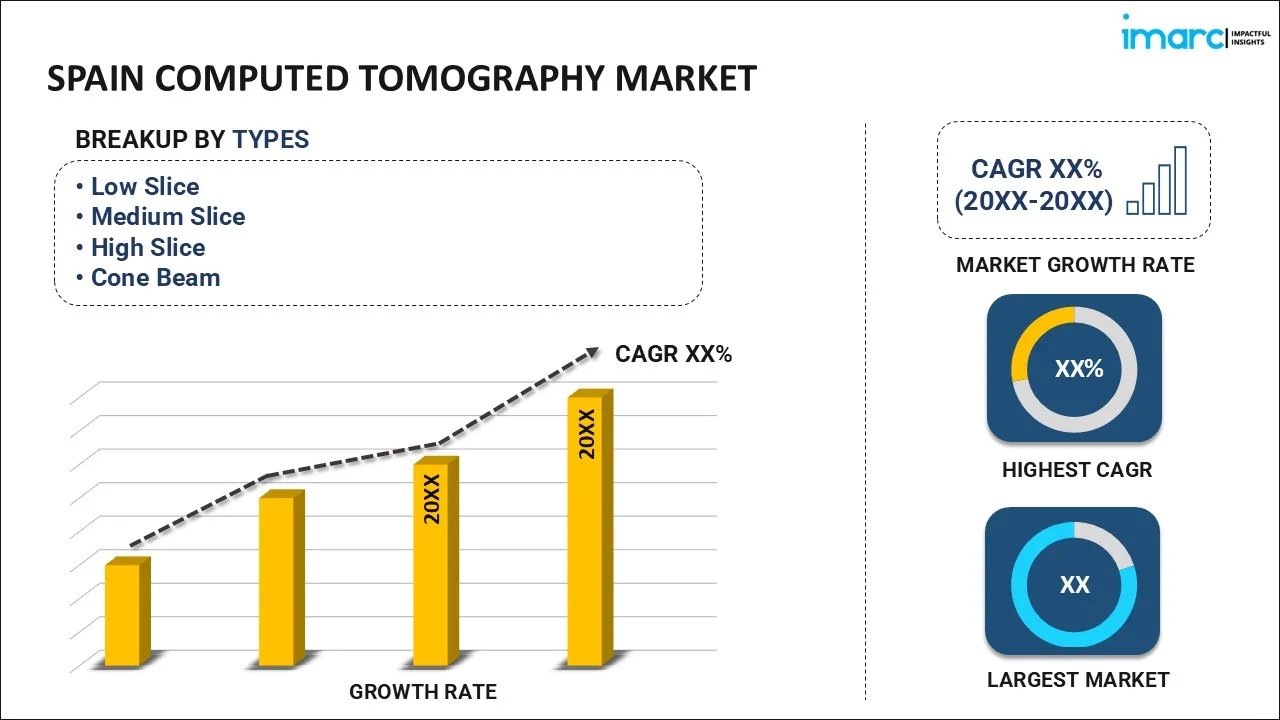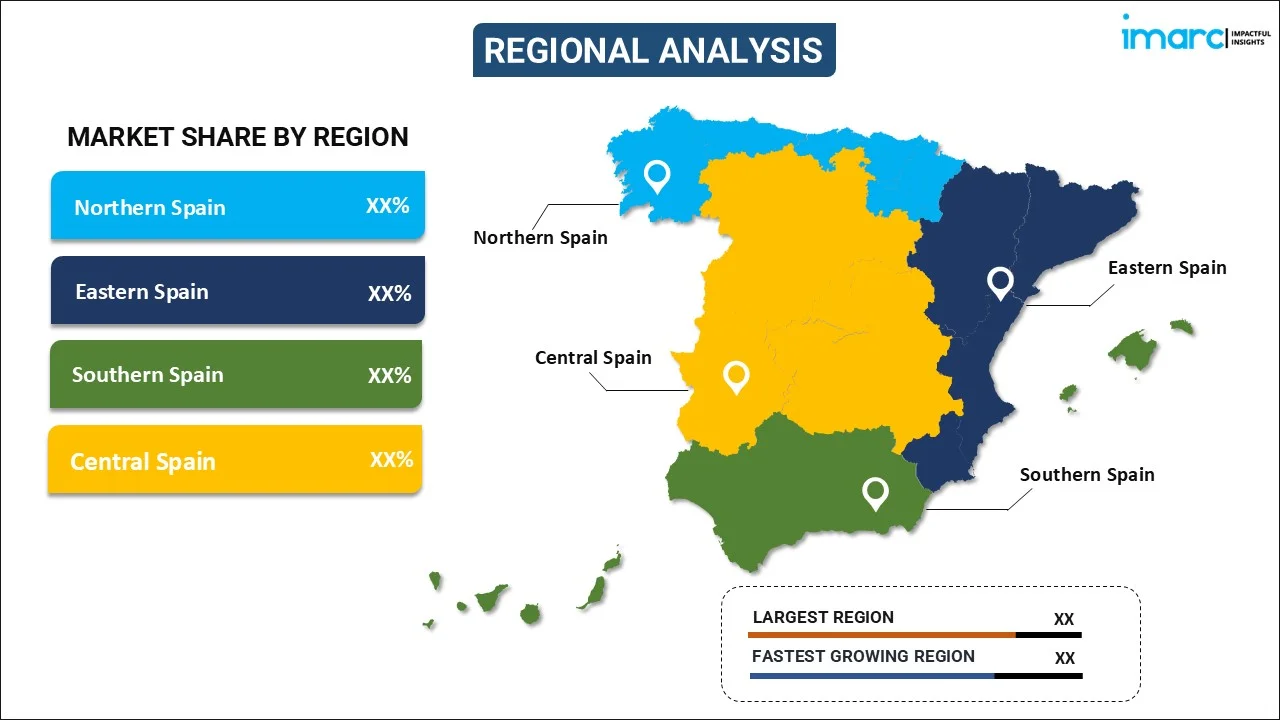
Spain Computed Tomography Market Size, Share, Trends and Forecast by Type, Application, End User, and Region, 2025-2033
Spain Computed Tomography Market Overview:
The Spain computed tomography market size reached USD 0.08 Billion in 2024. Looking forward, IMARC Group expects the market to reach USD 0.12 Billion by 2033, exhibiting a growth rate (CAGR) of 5.07% during 2025-2033. Rising rates of chronic diseases, the need for early and precise diagnosis, technological developments in imaging systems, government healthcare programs, rising investments in radiology infrastructure, the aging population, and the growing use of AI-driven imaging solutions to improve diagnostic accuracy are all driving the market's expansion.
|
Report Attribute
|
Key Statistics
|
|---|---|
|
Base Year
|
2024
|
|
Forecast Years
|
2025-2033
|
|
Historical Years
|
2019-2024
|
| Market Size in 2024 | USD 0.08 Billion |
| Market Forecast in 2033 | USD 0.12 Billion |
| Market Growth Rate (2025-2033) | 5.07% |
Spain Computed Tomography Market Trends:
Rising Adoption of AI-Powered CT Imaging
AI in Spain is revolutionizing computed tomography to accelerate diagnostic accuracy and speed. CT systems enabled with AI are helping radiologists to identify abnormalities with greater accuracy through the improvement of image reconstruction and scan interpretation, leading to diagnoses made at an earlier time. These technologies are being incorporated by clinics and hospitals to advance patient care through reducing scan time, making processes efficient, and preventing human errors. AI radiology is becoming an essential part of Spain's efforts to revolutionize medical imaging, fueled by growing investment from the public and private sectors. For example, Spain's National AI Strategy is designed to apply AI to the economy and society across various disciplines. The government of Spain invested €600 million until 2023 in AI development, with emphasis on human capital, scientific excellence, ethical AI, and digital transformation. Major initiatives involve increasing AI education, improving research, funding AI startups, and encouraging AI adoption in the public and private sectors. Keeping EU policies for sustainable digital development, Spain also invests in cybersecurity, high-performance computing, and AI use in public services. The requirement for hospitals to make better use of their resources in light of the rising number of patients and the necessity of advanced diagnostic machines is another force behind this trend.
Expansion of Teleradiology Services for Remote Diagnostics
Teleradiology is gaining traction in Spain due to the increasing need for remote diagnostic services. For instance, as per industry reports, Spain's teleradiology market size is estimated to reach USD 103 Million in 2030, registering a CAGR of 10.7%. The proliferation of high-speed internet and cloud-based imaging platforms provides radiologists with the opportunity to assess CT scans from any location, barring geographical barriers, reducing waiting periods, and improving accessibility for rural and underserved regions. This trend is particularly relevant given the shortage of radiologists in certain areas, where telemedicine solutions help bridge diagnostic gaps. Spain’s healthcare system is increasingly utilizing teleradiology to enhance efficiency and ensure timely diagnoses, particularly in emergency cases. Additionally, collaborations between private imaging centers and hospitals are driving the development of centralized radiology networks. In another instance, in November 2024, United Imaging, in collaboration with APR Salud, installed Spain’s first uMR 680 MRI at HM Málaga Hospital. This AI-driven 1.5T system delivers 3.0T-like image quality, enhancing diagnostics with Deep Learning-based reconstruction, 97% noise reduction, and contactless respiratory motion tracking. The 70cm wide bore improves patient comfort, while whole-body imaging increases efficiency. As digital health initiatives expand, teleradiology is set to play a critical role in enhancing CT scan interpretation and overall patient outcomes.
Spain Computed Tomography Market Segmentation:
IMARC Group provides an analysis of the key trends in each segment of the market, along with forecasts at the region/country level for 2025-2033. Our report has categorized the market based on type, application, and end user.
Type Insights:

- Low Slice
- Medium Slice
- High Slice
- Cone Beam
A detailed breakup and analysis of the market based on the type have been provided in the report. This includes low slice, medium slice, high slice, and cone beam.
Application Insights:
- Oncology
- Neurology
- Cardiovascular
- Musculoskeletal
- Others
A detailed breakup and analysis of the market based on the application have also been provided in the report. This includes oncology, neurology, cardiovascular, musculoskeletal, and others.
End User Insights:
- Hospitals
- Diagnostic Centers
- Others
A detailed breakup and analysis of the market based on the end user have also been provided in the report. This includes hospitals, diagnostic centers, and others.
Regional Insights:

- Northern Spain
- Eastern Spain
- Southern Spain
- Central Spain
The report has also provided a comprehensive analysis of all the major regional markets, which include Northern, Eastern, Southern, and Central Spain.
Competitive Landscape:
The market research report has also provided a comprehensive analysis of the competitive landscape. Competitive analysis such as market structure, key player positioning, top winning strategies, competitive dashboard, and company evaluation quadrant has been covered in the report. Also, detailed profiles of all major companies have been provided.
Spain Computed Tomography Market News:
- In December 2024, Philips announced advancements in cardiac CT technology to enhance patient care through AI, spectral imaging, and smart workflow solutions. The Spectral CT 7500 improves diagnostic accuracy while reducing scan times and radiation exposure. AI-powered imaging enables precise, low-dose cardiac assessments, supporting overburdened imaging departments. Philips’ integration of hardware, software, and AI enhances accessibility, efficiency, and clinical collaboration in cardiac diagnostics.
- In December 2024, Siemens Healthineers expanded its photon-counting CT portfolio with the Naeotom Alpha class, introducing Naeotom Alpha.Pro and Naeotom Alpha.Prime. These scanners enhance image quality while minimizing radiation exposure, advancing diagnostics and treatment pathways. The Naeotom Alpha.Prime became the world’s first single-source photon-counting CT, designed for diverse healthcare settings.
Spain Computed Tomography Market Report Coverage:
| Report Features | Details |
|---|---|
| Base Year of the Analysis | 2024 |
| Historical Period | 2019-2024 |
| Forecast Period | 2025-2033 |
| Units | Billion USD |
| Scope of the Report |
Exploration of Historical Trends and Market Outlook, Industry Catalysts and Challenges, Segment-Wise Historical and Future Market Assessment:
|
| Types Covered | Low Slice, Medium Slice, High Slice, Cone Beam |
| Applications Covered | Oncology, Neurology, Cardiovascular, Musculoskeletal, Others |
| End Users Covered | Hospitals, Diagnostic Centers, Others |
| Regions Covered | Northern Spain, Eastern Spain, Southern Spain, Central Spain |
| Customization Scope | 10% Free Customization |
| Post-Sale Analyst Support | 10-12 Weeks |
| Delivery Format | PDF and Excel through Email (We can also provide the editable version of the report in PPT/Word format on special request) |
Key Questions Answered in This Report:
- How has the Spain computed tomography market performed so far and how will it perform in the coming years?
- What is the breakup of the Spain computed tomography market on the basis of type?
- What is the breakup of the Spain computed tomography market on the basis of application?
- What is the breakup of the Spain computed tomography market on the basis of end user?
- What are the various stages in the value chain of the Spain computed tomography market?
- What are the key driving factors and challenges in the Spain computed tomography market?
- What is the structure of the Spain computed tomography market and who are the key players?
- What is the degree of competition in the Spain computed tomography market?
Key Benefits for Stakeholders:
- IMARC’s industry report offers a comprehensive quantitative analysis of various market segments, historical and current market trends, market forecasts, and dynamics of the Spain computed tomography market from 2019-2033.
- The research report provides the latest information on the market drivers, challenges, and opportunities in the Spain computed tomography market.
- Porter's Five Forces analysis assist stakeholders in assessing the impact of new entrants, competitive rivalry, supplier power, buyer power, and the threat of substitution. It helps stakeholders to analyze the level of competition within the Spain computed tomography industry and its attractiveness.
- Competitive landscape allows stakeholders to understand their competitive environment and provides an insight into the current positions of key players in the market.
Need more help?
- Speak to our experienced analysts for insights on the current market scenarios.
- Include additional segments and countries to customize the report as per your requirement.
- Gain an unparalleled competitive advantage in your domain by understanding how to utilize the report and positively impacting your operations and revenue.
- For further assistance, please connect with our analysts.
 Inquire Before Buying
Inquire Before Buying
 Speak to an Analyst
Speak to an Analyst
 Request Brochure
Request Brochure
 Request Customization
Request Customization




.webp)




.webp)












